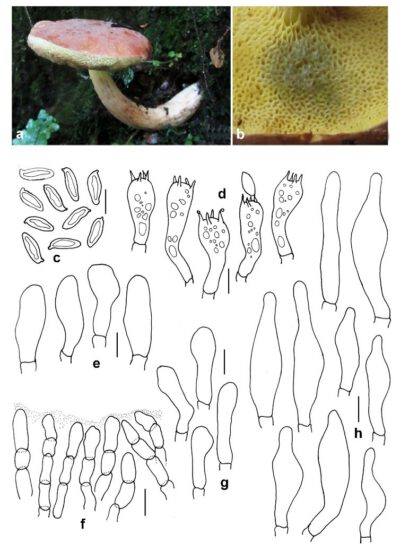Fungalpedia – Note 204, Xerocomus
Xerocomus Quél.
Citation if using this entry: Bera et al. 2024 (in prep) – Fungalpedia, Basidiomycota 1.
Index Fungorum, MycoBank, Facesoffungi, GenBank, Fig. 1
Classification: Boletaceae, Boletales, Agaricomycetes, Basidiomycota, Fungi.
Xerocomus was first introduced by Quélet (1887) and typified by X. subtomentosus (L.) Quél. (Quélet 1888). The systematic classification of Basidiomycetes has traditionally relied on the morphology of basidiomata, and Xerocomus has adhered to this convention for many years. The generalized application of the name “Xerocomus” to a diversity of taxa has reflected its heterogeneity and has led to many synonyms (Singer 1986, Ladurner & Simonini 2003, Zhang et al. 2013). Some mycologists have often merged Xerocomus into Boletus L., while others regard it as a distinct genus (Watling & Hills 2005, Hills 2008, Zhang et al. 2013). It was suggested that based on the characteristics of the hymenophoral trama, the European species of Boletus can be distinguished from Xerocomus. However, non-European ones will still be ambiguous (Singer 1945, Oolbekkink 1991, Lee et al. 2023).
Phylogenetic studies have inferred the non-monophyletic nature of Xerocomus (Binder & Hibbert 2006). It has always been challenging to distinguish the species in Xerocomus (Peintner et al. 2003). For most of them, the typical ornamentation of the basidiospores, hymenophoral trama of phylloporoid and non-gelatinous nature, non-glutinous trichoderm type of pileipellis and non-gelatinous, loosely arranged, divergent lateral stratum in the peripheral layers of the stipe, are characteristic features of Xerocomus species (Šutara 2008). The study of basidiospore morphology has become an important morphological character to delimit the taxa in this genus (Lee et al. 2023).
The multi-gene (LSU, tef1-α, rpb1, and rpb2) phylogenetic analyses of Xerocomus revealed six lineages: Xerocomus s.str., Hemileccinum Šutara, Xerocomellus Šutara, and three other unnamed clades (Wu et al. 2014). Bacillate spore ornamentation is the defining characteristic of Xerocomus s.str. (Šutara 2008). The overall slender and less fleshy appearance of the basidiomata, pileus surface never viscid or glutinous when wet, and angular pores at maturity of ca 1–3 mm adnate tubes of 15 mm long are some of the identifying characters of the members of Xerocomus s.str. (Šutara 2008). This ectomycorrhizal boletoid genus currently encompasses around 115 species, according to the documentation under Species Fungorum (2023).
Synonyms: Versipellis Quél.,
Type species: Xerocomus subtomentosus (L.) Quél.
Other accepted species: (Species Fungorum – search Xerocomus)
Figure 1 – Xerocomus longistipitatus (holotype, DC 16-056). a Fresh basidiomata. b Pore surface. c Basidiospores. d Basidia. e Caulocystidia. f Pileipellis. g Cheilocystidia. h Pleurocystidia. Scale bars: c–e, g & h = 10 μm, f = 25 μm. Taken from Chakraborty et al. (2017).
References
Ladurner H, Simonini G. 2003 – Xerocomus s. l. Fungi Europaei, vol. 8. Edizioni Candusso, Alassio.
Quélet L. 1887 – Xerocomus. In: Mougeot, A., Ferry, R. & Roumeguère, G. (eds.) La flore des Vosges, Champignons, Algues: In: Louis, L. Le Département des Vosges, Description – Histoire – Statistique. Tome II. La flore des Vosges. Épinal: E. Busy. 477–478.
Quélet L. 1888 – Flore mycologique de la France. Paris, France.
Entry by
Ishika Bera, Center of Excellence in Fungal Research, Mae Fah Luang University, Chiang Rai 57100, Thailand
(Edited by Kevin D Hyde, Samaneh Chaharmiri-Dokhaharani, & Achala R. Rathnayaka)
Published online 15 February 2024
